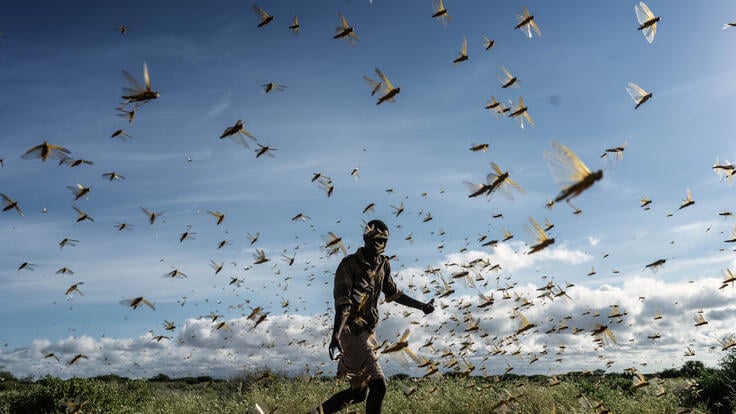The worst locust outbreak in generations has descended upon East Africa and the Horn of Africa. Without immediate action, 4.9 million people could face starvation this summer. This disaster comes at the worst possible time for countries like Somalia already facing the double emergency of food shortage and COVID-19.
The International Rescue Committee (IRC) and our local partners are responding to the evolving crisis, while simultaneously advocating for critical aid worldwide. Our teams are on the ground training communities, providing direct assistance to farmers and livestock herders, and helping the most vulnerable—particularly women and girls—who face a devastating hunger crisis.
Here are seven facts about the situation on the ground:
Desert locusts are extremely dangerous.
These migratory insects inflict insurmountable damage in minutes. Even a tiny swarm consumes the same amount of food in one day as 35,000 people. Swarms have already destroyed hundreds of thousands of hectares of crops and pastureland in eight countries—Kenya, Uganda, South Sudan, Ethiopia, Somalia, Eritrea, Djibouti and Sudan—and threaten to spread wider.
Five million people are at risk of hunger and famine.
As of March, the locust infestation in East Africa has already damaged more than 25,000 kilometers of cropland. Without swift intervention, populations will face mass starvation this summer.
A new swarm is hatching.
A fourth generation of locust eggs is now hatching, which experts predict will create a locust population 8,000 times larger than the current infestation. This coincides with the start of harvest season, and will be compounded by the COVID-19 emergency. Pasture for livestock is also in jeopardy.

Somalia will likely be hit hardest.
The Somali government was first in the region to declare a nationwide emergency in response to the desert-locust crisis. Without humanitarian assistance, 3.5 million people are projected to face food crisis between July and September. The region is already overwhelmed by cycles of widespread violence, drought, floods, chronic food shortages, and disease.
This the worst outbreak in 70 years.
Without expedited preventative measures, swarms will migrate from East Africa to West Africa. “This is the worst locust invasion we have seen in our generation,” says Sahal Farah of Docol, an IRC partner organization. “It destroyed pastures, contaminated water sources and [has] displaced many pastoral households. The worst of all is that we do not have the capacity to control it, and so far we have not received any external support.”
Women face increased risk.
If harvests fail, the IRC estimates that 5,000 households, especially those led by women, will need urgent humanitarian assistance by August. As food prices skyrocket, women and girls will face an increase in violence and theft as their partners are forced to travel in search of food and work. Additionally, women will be forced to take on additional responsibilities in managing existing farms or small businesses, even as they tend to the needs of their families.
More funding is necessary to stop widespread famine.
The IRC is calling for $1.98 million to alleviate the desert-locust emergency in Somalia in 2020. We are also appealing to the United Nations and affected countries to continue technical analysis of locust movements along with continued information sharing—before it is too late.
Learn more
Read our new report: The double burden of COVID-19 and locusts in East Africa